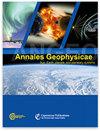The Cluster spacecraft's view of the motion of the high-latitude magnetopause
IF 1.9
4区 地球科学
Q3 ASTRONOMY & ASTROPHYSICS
引用次数: 0
Abstract
Abstract. The boundary between the interplanetary magnetic field and the terrestrial magnetic field is the magnetopause. This magnetopause is influenced by dynamic changes in the solar wind, that is different solar wind conditions lead to a change in the shape and location of the magnetopause. The interaction between the solar wind and the magnetosphere can be studied from in-situ spacecraft observations. Many studies focus on the equatorial plane, as this is where recent spacecraft constellations such as THEMIS or MMS operate. However, to fully capture the interaction, it is important to study the high latitude regions as well. The Cluster spacecraft allow us to collect a dataset of high-latitude magnetopause crossings and study magnetopause motion in this region, as well as deviations from established magnetopause models. We use multi-spacecraft analysis tools to investigate the direction of magnetopause motion in the high latitudes and compare the occurrence of crossings at different locations with the result in the equatorial plane. We find that the high-latitude magnetopause motion is generally consistent with previously reported values and seems to be more often associated with a closed magnetopause boundary. We show that on average the magnetopause moves faster inwards than outwards. Furthermore, the occurrence of magnetopause positions beyond those predicted by the Shue et al. (1998) model at high latitudes is found to be caused by the similar solar wind parameters as in the equatorial plane. Finally, we highlight the importance of the dipole tilt angle at high latitudes. Our results may be useful for the interpretation of plasma measurements from the upcoming SMILE mission (Branduardi-Raymont et al., 2018), as this spacecraft will also fly frequently through the high-latitude magnetopause.星簇航天器对高纬度磁层顶运动的观察
摘要行星际磁场和地球磁场之间的边界是磁极。磁层顶受到太阳风动态变化的影响,即不同的太阳风条件会导致磁层顶的形状和位置发生变化。太阳风和磁层之间的相互作用可以通过航天器的现场观测进行研究。许多研究侧重于赤道面,因为这是 THEMIS 或 MMS 等最新航天器星座的运行位置。然而,要充分捕捉相互作用,还必须对高纬度地区进行研究。星簇航天器使我们能够收集高纬度磁极穿越数据集,并研究该区域的磁极运动以及与既定磁极模型的偏差。我们使用多航天器分析工具来研究高纬度地区的磁层顶运动方向,并将不同位置的交叉发生情况与赤道平面的结果进行比较。我们发现,高纬度磁层顶运动与之前报告的数值基本一致,似乎更经常与封闭的磁层顶边界有关。我们发现,磁层顶平均向内移动的速度快于向外移动的速度。此外,我们还发现在高纬度地区出现超出 Shue 等人(1998 年)模型预测的磁层顶位置是由与赤道面类似的太阳风参数造成的。最后,我们强调了偶极子倾斜角在高纬度地区的重要性。我们的结果可能有助于解释即将进行的 SMILE 任务(Branduardi-Raymont 等人,2018 年)的等离子体测量结果,因为该航天器也将频繁飞越高纬度磁层顶。
本文章由计算机程序翻译,如有差异,请以英文原文为准。
求助全文
约1分钟内获得全文
求助全文
来源期刊

Annales Geophysicae
地学-地球科学综合
CiteScore
4.30
自引率
0.00%
发文量
42
审稿时长
2 months
期刊介绍:
Annales Geophysicae (ANGEO) is a not-for-profit international multi- and inter-disciplinary scientific open-access journal in the field of solar–terrestrial and planetary sciences. ANGEO publishes original articles and short communications (letters) on research of the Sun–Earth system, including the science of space weather, solar–terrestrial plasma physics, the Earth''s ionosphere and atmosphere, the magnetosphere, and the study of planets and planetary systems, the interaction between the different spheres of a planet, and the interaction across the planetary system. Topics range from space weathering, planetary magnetic field, and planetary interior and surface dynamics to the formation and evolution of planetary systems.
 求助内容:
求助内容: 应助结果提醒方式:
应助结果提醒方式:


